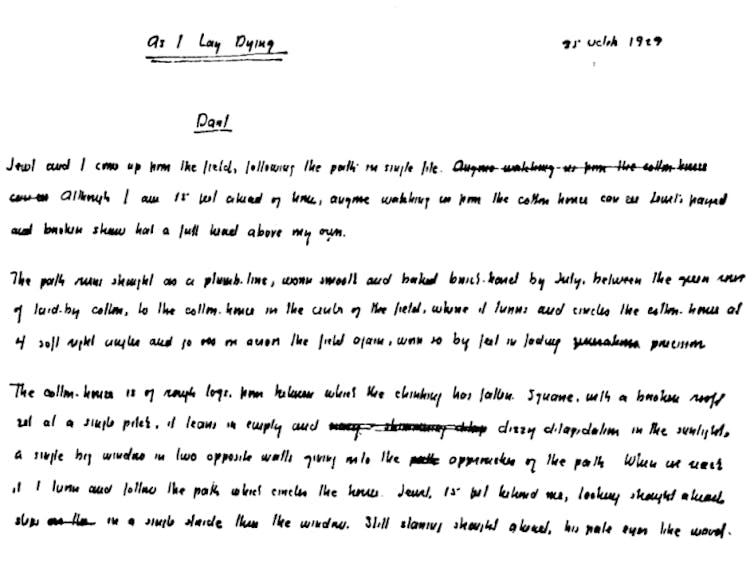Faulkner’s As I Lay Dying, published in 1930, is markedly one of the first novels to introduce stream of consciousness narration to the public. Faulkner wrote the entirety of the novel over the course of six weeks, from midnight until 4am, during his break at the power plant where he was working. It is interesting to note that the first page of the novel’s manuscript is dated October 25th, 1929; this is the day after “Black Thursday,” and for this reason As I Lay Dying is often considered the first Great American Novel of the Great Depression era.
This novel set the tone for American literature of the Great Depression. A review of the book, published in the Southwest Review in January 1931, revealed an attitude of shock at the realism with which Faulkner wrote. He is considered revolutionary for his “preoccupation with unusual mental states,” especially in regards to Darl’s madness (xvi). However, in 1930, mental illness and psychological issues were still taboo and were treated very differently from what we are accustomed to. In an account co-written by a patient and member of staff at the Oregon State Hospital in 1936, it is revealed that though attitudes toward mental illness had evolved from beliefs of the insane to be possessed by the devil, there was still a lack of knowledge about “the big hospital at the end of Center Street.” The patient, who was given the alias James R. Robblett, was indicated as one of the few patients cognizant enough to accurately portray his experience. He states that he was brought their because “My relatives, knowing no other course, arranged a commitment.” In the first half of the 20th century, few people knew how to help those they loved who were afflicted with mental illness. There was not widespread information about it like there is today, so instead families would send their own away to be hopefully cured. There was a lot of emphasis placed on the initial medical exam, and the hope that there would be a physical explanation for a patient’s mental deficiencies. James notes his heart, lungs, and blood were all examined. Though this account was published in Sunday Oregonian in June 14, 1936, which proved that there was a desire for the public to be more aware of the conditions in mental hospitals at the time, there were still societal prejudices reflected even in James’s testimony. He says at the end of the entry, “Everybody looked all right, but I had been there long enough to know that most of them were crazy as loons.” The notion of calling people with mental health issues “crazy” was still very common, and there was a distinct “other”-ing of this demographic from what was considered to be the “norm.” The image below shows electroconvulsive therapy, which came to the United States in 1939 and was supposed to induce seizures to cure and provide relief for the mentally ill. This reveals the deep lack of understanding for mental health patients that persisted at this time.
It is morbidly ironic that there was such a grave misunderstanding of mental illness during the onset of the Great Depression, when Faulker’s novel was published, as it became an even more pervasive issue during this critical time. The suicide rate spiked to its highest level on record, and more than 40,000 Americans took their own lives in 1937. As I Lay Dying is situated amidst this economic turmoil on a societal scale and mental turmoil on an individual scale. In the Southwest Review article H.S. concludes that “Faulkner is unusual in the lurid intensity of his outlook,” as in he avoids the “sweetness and light” that were conventional of literature published during his time. By presenting the tale of the Bundren family with such a degree of poignancy that it made reviewers at the time uncomfortable, Faulker gets at the reality of life. He doesn’t shy away from Darl’s madness, rather he uses the stream of consciousness narration to expose it. By employing this mode of narration, it makes all of the characters seem a bit mad, and it makes mental illness more accessible to readers than was considered customary in the early 1930s in America.
You draw attention to an important and consistent recurring theme in Faulkner’s novels: the emphasis on damaged bodies and mental illness. I like how you show how the specific emphasis on Darl’s “madness” (he is, at least, pathologized by those around him) becomes more diffuse as we get a glimpse into the chaotic, shifting, minds of the various characters here. It’s an interesting point that this technique would have made mental illness more accessible to readers; if anything, for a typical reader, I would think it would make them doubt Faulkner’s sanity! Joking aside, I see what you mean here as Faulkner gives us apparently unmediated access to altered and intensified mental states under the stress of extreme mental and physical pressure.